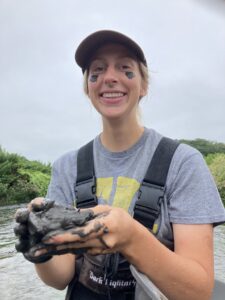With a grant from the Freshwater Collaborative of Wisconsin, six undergraduates were selected for the “The Dam Analysis and Monitoring Crew,” a two-week field experience during which they were trained to provide monitoring for a dam removal project in River Falls. The DAM Crew is a cooperative effort involving UW-River Falls, the Kiap-TU-Wish Chapter of Trout Unlimited, the Kinni Corridor Collaborative and Inter-Fluve. Read more at Dam Removal Project Opens Flow of Community-based Training and Research.
Jordyn Curtis and Mckenna Kellogg, Conservation majors at UW-River Falls, have continued work on the project as interns. Here’s what they had to say about their experience.
Why did you participate in this field research?
Curtis: I was in a hydrology course last spring, and I loved the material we were learning. This was an opportunity to get hands-on experience. And I like fishing, and the Kinnickinnic is good for trout fishing!
Kellogg: I also wanted the hands-on experience. I wanted to see what I could do in a future career if I wanted to work with water.
What did you learn?
Curtis: I had only had one water course before the DAM Crew, so I learned a lot about why temperature changes are super important to the trout. I learned how to do geomorphic surveys and why they are important. We looked at the vegetation and what that tells you. As a group we drew out how we thought the stream would meander once the dams were taken out and looked at how that would affect our plans of putting in a trail that everyone could access.

It also helped us work on our teamwork skills. You work on that a bit in school in group projects, but this is very different. It was unique working with a team of 10 to 12 people.
Kellogg: I enjoyed learning about how the geomorphology changed based on where we were located in the river. In the impoundment between the two dams, you have 8-foot-tall clay walls of sediment built up. Sean [Morrison with Inter-Fluve] had us design what we thought the area should look like after the dam is removed. He had so much information about why we couldn’t put certain things in a certain area because in a few years after they’ve done the work, it will change. For example, if we put a kayak launch over here, it will get washed away in two years.
What was the benefit to interacting with different faculty and working professionals?
Kellogg: I really had only experienced what I could through class or if somebody came to campus to talk. Professors have to be more objective and tell you the various ways you could do something, and you have to decide what’s best. Getting in the field, you get to see how people work hands-on in their careers every day. That was interesting and gives you a new perspective on what you want to do with your future.
Curtis: Seeing how the Wisconsin DNR and Trout Unlimited and the Kinni Land Trust all work together was eye opening for me. Kent [Johnson from Trout Unlimited] and Sean gave us a very different point of view than our professors. Sean showed us so many different projects that he’s he worked on, problems he’s had to deal with and what they did. You could see before and after. That was helpful.
You were both hired as interns to continue the project. What have you been doing?
Curtis: We just started, so we’ve been looking at archives of arial photos to see what Lake Louise looked like in 1958 and looking at plot maps to see how things have changed.
Kellogg: What we did during the summer was geomorphology surveys and vegetative cover. We’ll continue to gather more data. We also want to do soil core samples and sedimentation inventory. Jordyn is talking about doing a sedimentation study at the mouth of the river where it meets St. Croix. We kind of have free reign of what we want to research.
I’m very appreciative they gave us the opportunity to continue all the study from the summer. They trust us with this independent research and believe in us to be able to create a framework for future interns. Because we’re at the beginning of this project, we get to lay the groundwork for it to expand. Ten years down the road we’ll get to see what people have done with it.
Curtis: Exactly. We’re pioneers.
What are your career goals and how will this experience help you attain them?
Kellogg: What I love about a conservation degree is that it opens you up to work in pretty much any discipline. I really like what I do now [as a park ranger for the WDNR] and I would like to continue to work for the DNR. I think it could be fun to work in water — maybe aquatic surveying, which would be a fun mix between field studies and data analysis.
Curtis: The DAM Crew and this internship have taught me how to gather, consolidate and use data. Doing vegetation surveys for the DAM Crew this spring will make me better at plant ID, and doing more with the soil will give me more background information for forestry. I have a position with the Forestry Service as a forestry crew technician starting in May in Superior National Forest. That was the best result I could have hoped for.

